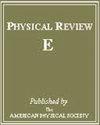混合穿透壁之间的超封闭扁球形硬颗粒。
摘要
我们通过蒙特卡洛模拟研究了限制在可控穿透性混合壁之间的盘状液晶(DLC)极薄薄膜的取向结构与壁间距 L_{z} 的函数关系。我们的目的是要弄清楚,当 L_{z} 和两侧壁的锚定强度发生变化时,DLC 的优先取向是否如连续理论所预测的那样是均匀的、线性变化的,还是不连续变化的。该模型由扁球形硬高斯重叠(HGO)颗粒组成:每个壁将颗粒视为厚度为零、直径 D 小于或等于实际颗粒直径 σ_{0} 的圆盘,嵌入颗粒内部,并位于颗粒次轴线的中段并与其垂直。这就提供了一种粒子级的机制来控制壁的锚定特性,从 D∼0 的平面(边缘朝上)到 D∼σ_{0} 的各向同性(面朝上),这可以在任一壁上独立完成。正如我们之前的研究 [C. Anquetil-Deck et al.Anquetil-Deck 等人,J. Phys.B 124, 7709 (2020)1520-610610.1021/acs.jpcb.0根据顶壁(D_{s}^{t})和底壁(D_{s}^{b})上的 D_{s}≡D/σ_{0} 值,我们在 (D_{s}^{b},D_{s}^{t})空间中找到了粒子排列为均匀平面(UP)的域、均匀各向同性(UH),或从一侧壁的平面到另一侧壁的各向同性线性变化(L),但在这些域之间没有发现双稳态或三稳态区域。最重要的是,当壁强烈倾向于不同的锚定时,低浓取向似乎从未发生过突然变化,这与 Velasco 及其合作者提出的设想基本一致 [D. de las Heras et al.,Phys. Rev. E 79, 011712 (2009)1539-375510.1103/PhysRevE.79.011712],但与等效钙钛矿系统的行为相反 [F. Barmes et al.E,69,061705 (2004)1539-375510.1103/PhysRevE.69.061705;Phys. Rev. E,71,021705 (2005)1539-375510.1103/PhysRevE.71.021705;C. Anquetil-Deck 等人,Phys. Rev. E 86, 041707 (2012)1539-375510.1103/PhysRevE.86.041707]。然而,对于所研究的最薄薄膜(L_{z}=2σ_{0}),该系统无法容纳首选粒子方向从一侧壁旋转到另一侧壁,而是采用倾斜配置,这与早先报道的对称约束下的盖-伯恩薄膜类似 [T. Gruhn et al.Gruhn 等人,Thin Solid Films 330,46 (1998)0040-609010.1016/S0040-6090(98)00799-8;Mol.93,681 (1998)10.1080/002689798169014],但据我们所知,大多数早期工作都忽略了这一点。We have investigated, by Monte Carlo simulation, the orientational structure of very thin films of a discotic liquid crystal (DLC) confined between hybrid walls of controllable penetrability, as a function of wall separation L_{z}. Our purpose was to clarify whether, as predicted by continuum theory, the preferred orientation of the DLC is uniform, changes linearly, or changes discontinuously, when L_{z} and the anchoring strengths at either wall are changed. The model consists of oblate hard Gaussian overlap (HGO) particles: each wall sees a particle as a disk of zero thickness and diameter D less than or equal to that of the actual particle σ_{0}, embedded inside the particle and located halfway along, and perpendicular to, its minor axis. This provides a particle-level mechanism to control the anchoring properties of the walls, from planar (edge-on) for D∼0 to homeotropic (face-on) for D∼σ_{0}, which can be done independently at either wall. As in our earlier work [C. Anquetil-Deck et al., J. Phys. Chem. B 124, 7709 (2020)1520-610610.1021/acs.jpcb.0c05027], which was restricted to L_{z}=6σ_{0}, depending on the values of D_{s}≡D/σ_{0} at the top (D_{s}^{t}) and bottom (D_{s}^{b}) walls, we find domains in (D_{s}^{b},D_{s}^{t}) space in which particle alignment is uniform planar (UP), uniform homeotropic (UH), or varies linearly from planar at one wall to homeotropic at the other (L), but no bistable or tristable regions are identified between these domains. Most importantly, there appears never to occur an abrupt change of the LC orientation when the walls strongly favor different anchorings, in general agreement with the scenario proposed by Velasco and co-workers [D. de las Heras et al., Phys. Rev. E 79, 011712 (2009)1539-375510.1103/PhysRevE.79.011712], but in contrast to the behavior of equivalent calamitic systems [F. Barmes et al., Phys. Rev. E 69, 061705 (2004)1539-375510.1103/PhysRevE.69.061705; Phys. Rev. E, 71, 021705 (2005)1539-375510.1103/PhysRevE.71.021705; C. Anquetil-Deck et al., Phys. Rev. E 86, 041707 (2012)1539-375510.1103/PhysRevE.86.041707]. However, for the thinnest films investigated (L_{z}=2σ_{0}), the system is unable to accommodate a rotation of the preferred particle orientation from one wall to the other and adopts instead a tilted configuration, similar to that reported earlier for Gay-Berne films in symmetric confinement [T. Gruhn et al., Thin Solid Films 330, 46 (1998)0040-609010.1016/S0040-6090(98)00799-8; Mol. Phys. 93, 681 (1998)10.1080/002689798169014] but which, as far as we know, has been missed in most earlier work.

 求助内容:
求助内容: 应助结果提醒方式:
应助结果提醒方式:


